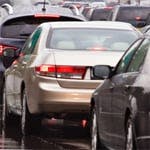Traffic congestion is a major issue in our busy cities, and it’s only going to get worse. So what do you need to be aware of when organising your business’ fleet?
One of the biggest frustrations of our age is congestion on the road. We live in a society demanding immediacy. We don’t like to wait. Think about this in the context of what it means to business and the paradigm only shifts and intensifies. It is no longer about what we like or don’t like, but what we need to stay competitive. Australia has a great deal to love about it, but its ailing transportation infrastructure leaves a lot to be desired when compared to other first world nations. On the global stage we are under time and cost pressure. Patience is a virtue our economy can ill afford.
Sydney is the fourth-worst major city in the world for transport and infrastructure according to PricewaterhouseCoopers. Over two thirds of weekday journeys across Sydney are by private vehicle and NRMA’s research suggests up to 25 percent more capacity can be achieved from Sydney’s motorways simply by changing the way they are managed and by adopting proven technology.
With Sydney’s population expected to explode by 23 percent over the next 20 years, just slightly faster than NSW at 20 percent, it is a serious concern to know 78 percent of businesses believe it takes longer to get to work than it did 12 months ago.
If it is indeed true that leveraging technology will enable a more efficient road system, this must become a top priority for both the public and private sector because it’s not just a problem for Sydney-siders or New South Welshmen, the interconnected nature of our infrastructure means it’s a nation-wide issue.
The Bureau of Transport and Regional Economics forecasts that the avoidable annual cost of congestion of all Australian capital cities is estimated to be $20 billion by 2020 if left unchecked. That is double what it is today. It’s little surprise then that Prime Minister Julia Gillard has likened traffic in Sydney’s western suburbs to Los Angeles.
The Department of Transport and Regional Services reveals by 2020 the cost per city will be $7.8 billion for Sydney, $6.1 billion for Melbourne, $3.0 billion for Brisbane, $2.1 billion for Perth, $1.1 billion for Adelaide, $0.2 billion for Canberra, $70 million for Hobart, and $35 million for Darwin. It affects us all. The good news is there are steps you can take as a business owner to reduce the impact this will have on you.
The challenges we work through with customers every day at Navman Wireless almost always go back to this point – how to make smarter fleet management decisions on the go. Being armed with this intelligence is the key to mitigating the impact of infrastructure that is lagging behind. When you have a business that relies on its ability to get from A to B in a timely fashion, you simply must be able to have visibility of the best route but also be able to share live ETA with your customer. Transparency is key and servicing this need is mission critical.
The return on investment is easy to show on a system that allows you to push out turn-by-turn directions and job details to vehicles because it allows you to identify the closest, best-equipped vehicle for the task at hand while easily notify drivers of pertinent job information on the fly. When you can simultaneously receive delivery confirmations so that drivers can simply focus driving safely and getting on with the next job without lag time, it’s compelling. Why? Because the aforementioned issue of lost opportunity costs are but one problem when it comes to congestion on the roads. The other major point of conjecture is around extra vehicle operating costs, and the $1.1 billion in extra air pollution that recent studies show is quite literally clouding the issue.
We know that longer idle times, grinding through the gears and driver frustrations all result in increased maintenance and repair costs. We’ve seen the introduction of a carbon tax that enforces businesses to be conscious of their environment impact. It simply is not an option to pass over technology that will enable these obstacles to be avoided. So here’s a simple checklist you need to work through to understand what will work best for you. It consists of one item; one question that needs to be answered: do you rely on the roads for your business to function effectively? If the answer is yes, just run through those sums again. $20 billion in lost opportunity costs, not to mention servicing of vehicles and taxes. In business, in order to be successful you need to make lots of tough decisions. Fortunately this isn’t one of them. For the peace of mind of knowing you aren’t on the highway to hell, think about all you could achieve if you could have real time reports, alerts, logs and maps that give your unstructured data context. You aren’t in a positing to re-architect the transport infrastructure, but there are smarts out there that give you the insights you need to circumvent it, giving you the ability to make informed decisions that improve your business. It’s what we call Fleet and Mobile Asset Intelligence.

